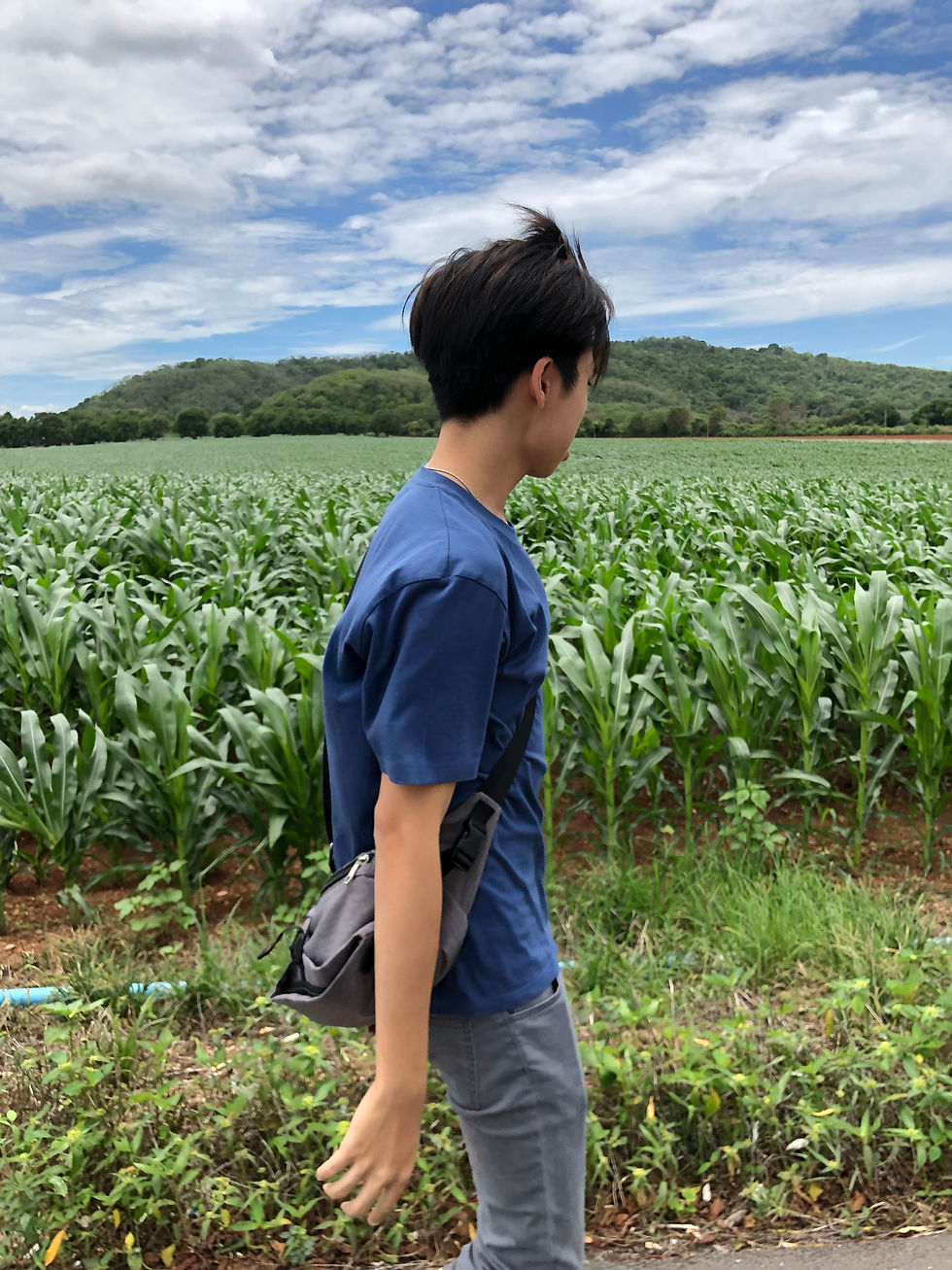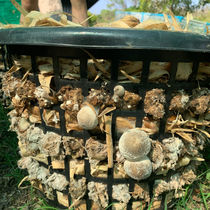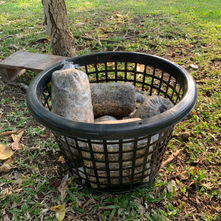top of page
TYME CAPSULE
Sustainable
Corn Wastes Project
Helping Thai Corn Farmers turning Corn Waste into A Sustainable Income
My Journey to Help Thai Corn Farmers
As a Thai-American that was born and raised in New Jersey, I’ve visited my grandparents in Nakhon Ratchasima, Thailand, almost every year growing up. During my time spent there, I've always observed the nearby cornfields from afar, as well as large piles of what looked like dried corn husks and cobs. Occasionally, there was mysterious smoke floating above the farms. I always wondered what exactly those piles were and where the smoke came from.
On a whim the summer of 2018, my siblings and I finally decided to go explore these corn fields. After getting much closer to these fields and talking with some of the corn farmers, I got a surprising glimpse into the struggles of corn farming, as well as the sheer amount of wasted byproducts during the farming process. I also found out that mysterious smoke in the air was from burning these corn byproducts.









1/2
Through my conversations with the corn farmers, I realized that the corn farming process had many flaws. One major downside was that, oftentimes, the corn's cobs and husks were either discarded or simply burned as they served no real purpose to the farmers. Sometimes farmers even had huge piles of leftover husk and corn cobs that just took up empty space for no reason at all. These piles of wastes also attracted bugs, birds, and rats which brought diseases to the area and smelled. To protect the outbreaks and reduce their impact on the community, the local government often asks the farmers to get rid of these wastes. I noticed that most of the farmers were quite old and did not have much education. They did not have abilities, skills, energies, or even motivation to incorporate new techniques into their routine. Regardless of the consequences, the farmers chose the easy way to get rid of the corn wastes by burning them, which adversely causes even more environmental issues.
I began to research ways the farmers could actually use these corn byproducts to their advantage, rather than waste them. More importantly, the suggested approaches must be easy and low cost to encourage the farmers to learn and try.
The objective of this project is to reuse the byproducts of corn, increase farmers' revenues, and decrease environmental issues.
I researched different ways to possibly use corn byproducts:
-
Using corn husks and cobs to make fertilizer
-
Using chopped corn cobs and husks to mix with animals food to feed to farm animals for extra amount of food and nutrients
-
Using corn husks to make paper
-
Using corn husks to make straws
-
Turning corn cobs into charcoal or fuel
Most of the above approaches are relatively complicated, which in turn, are not convincing for the farmers. I finally came across the research where people used rice hulls and similar types of husks to grow mushrooms. It was a “light bulb” moment for me - I should experiment growing mushrooms with corn husks. After navigating ways to grow mushrooms, I chose to grow them in baskets instead of in traditional farms as it is relatively low-cost, easy, and saves space.
After delving down into all options, I chose two possible methods: creating organic fertilizers, and growing mushrooms from corn wastes. The first method will generate organic fertilizers that the farmers can use in their farms, which will benefit not only the plants, but also the quality of the soil. This will automatically reduce the amount of commercial fertilizer used in the farms which in turn reduces the costs in the farms. During Christmas break in 2018, I started my experiment for both methods to ensure that they work before teaching them to larger groups of farmers in the community. They went quite well and I couldn't wait to make these two projects happen.
The show time has finally come. I came back to Thailand again in June 2019. The whole summer of 2019 I spent in Thailand is unlike other summers. It was so precious when I saw my idea become a reality. It is also a memorable and valuable moment for me as I started guiding the corn farmers to implement both approaches of reusing corn wastes. I want to prove to them that reusing corn byproducts is worth it. Corn wastes are not wasted anymore!
From corn wastes to organic nutritious fertilizers
The first approach was using leftover corn husks and cobs to create organic fertilizer. Making fertilizer was quite easy and required very little energy and maintenance. However, the downside of this method is that it is a time-consuming process. In my experiment batches, it took about 2.5 months to get the ready-to-use fertilizer.
Materials and costs for making organic fertilizers
10 parts of dried corn husks, cobs, dry leaves, and any organic waste
150 ml of Molasses (150 baht / 5 L) 4.50 baht
150 ml of EM (229 baht / 5 L) 6.87 baht
How to make organic fertilizers from corn wastes
Step 1: Create a layer of leftover pieces of corn, dry leaves, and any other organic waste.
Step 2: Add a layer of manure for more nutrition (in this case cow).
Step 3: Mix Effective Microorganisms (EM are a mixture of effective microorganisms), molasses, and water with the ratio of 1:1:1,000. This bio fermented solution will enhance the natural fertilizing processes. Sprinkle this solution over the compost piles.
Step 4: Repeat steps 1-3 until the pile reaches about chest height.
Step 5: Cover the prepared pile with hemp sack cloth or plastic tarp to help retain moisture.
Step 6: To speed up the process, flip and mix the mixtures around every week or two to let the air in. When you turn, check for moisture. If you spot dry patches, add water. If the compost looks soggy, add more corn husks or dry leaves.
Step 7: Continue step 6 for approximately 2-4 months until the pile has decomposed to around knee height. The finished fertilizer is dry, crumbly, and dark in color with an earthy smell.
From corn wastes to organic mushrooms
The second method I experimented with was using the excess parts of the corn, mainly the corn husks to grow mushrooms in the baskets. Due to Thailand's extreme humidity, the mushrooms can be grown all year round. They also grow extremely fast, taking only about 2 weeks to fully grow. These mushrooms are easy to grow organically without chemicals and do not need much close care. I enjoyed every step and was very excited to watch the mushrooms grow each day.
Materials for growing mushrooms
Corn husks
Mushroom spawn
Mushroom nutrients
PVC pipes
Plastic tarp
Costs of growing mushrooms in the baskets (20 baskets)
PVC + Plastic tarp 775 baht
20 Baskets (@ 20 baht per basket) 400 baht
10 Bags of Mushroom spawn (@15 baht per bag) 150 baht
4 Bags of Mushroom nutrients (@50 baht per bag) 200 baht
Total cost for the setup and the first 20 baskets 1,525 baht
Total cost per basket (for the first 20 baskets) 75.25 baht
Total cost per basket (after the first 20 baskets) 17.50 baht
How to use corn husks to grow mushrooms in the baskets
Step 1: Peel the corn husk into small pieces and soak in water overnight, then let it dry until slightly damp.
Step 2: Break the mushroom (spawn) into small pieces and sprinkle additional nutrients to help the mushrooms grow, then lightly mix.
Step 3: In a basket, first create a 3-inch layer of soaked corn husks then place the mushroom (spawn) into the slits around the inside walls of the basket.
Step 4: Repeat step 3 until the basket is full.
Step 5: Put the baskets in the shady areas with a little bit of sunlight.
Step 6: To create an appropriate environment for the growth of the mushrooms, I built a tent with PVC pipes and plastic tarp to cover the baskets.
Step 7: Every 3-4 days, Take off the tarp tent to air out the mushroom for about 2 hours per day.
Step 8: Check for moisture in the baskets. If they feel completely dry to touch, water them until damp.
From my experiment, I recommend putting a plastic tent over the mushroom baskets, so that the mushrooms can grow out white. Mushrooms that are exposed to more light will be darken faster. The whiter the mushrooms, the better the selling prices.
Each basket can be harvested 2 rounds. Each round yields about 1-2 kilograms of mushrooms per basket. I did market research and found that the mushrooms can be sold at 80-100 baht per kilogram in Thailand.
Estimated revenues and profits for 20 baskets of mushrooms

From the table above, it shows that the corn farmers can turn corn wastes into extra incomes around 1,695-6,495 baht per month after deducting the first time investment in the equipment setup. Later on, they will pay only for the mushroom spawn and nutrients and earn 2,850 - 7,650 baht per month, depending on the market prices of the mushrooms, from growing only 20 baskets.
Additionally, organic food and plant-based food are trendy in Thailand now. Mushrooms are good sources of protein and popular to use as an meat alternative in Thai cuisine. It won't be difficult for the corn farmers to sell and earn extra money for livings from selling these organic mushrooms.
Although I haven't been back in Thailand since the COVID-19 pandemic, I've continued to maintain communication and support the farmers as much as I can. I am happy to hear that more farmers in the area have started using these methods in their farms. The effect of the pandemic caused many young people in the community who had worked in Bangkok to lose their jobs. Many of them have come back to their hometown in rural regions. More and more people in the communities are interested in growing mushrooms from corn husks because it helps them to generate not only money for living, but also food for themselves. I also recommended the corn farmers to share their leftover corn husks with others in the area who do not own cornfields, so they can use them to grow mushrooms for their households. Besides, I suggested the farmers to turn extra fresh mushrooms into ready-to-eat mushroom derived food such as fermented mushrooms, Nam Prik Mushrooms, and seasoned dried mushrooms to earn extra money and prevent food wastes.
In October 2021, I heard from my grandparents that the area around Pak Chong in Thailand had floods. I had a chat with some of the farmers I have worked with and found out that some of their farms were flooded. Many of their fertilizers were gone. However, luckily, they were able to move the mushroom baskets into the save spots.
The above pictures were updated from one of the families in the community who did not own corn farm. He used corn wastes from the neighbor farm to start growing 4 baskets of mushrooms as food for his family during the COVID-19 pandemic.





bottom of page
























